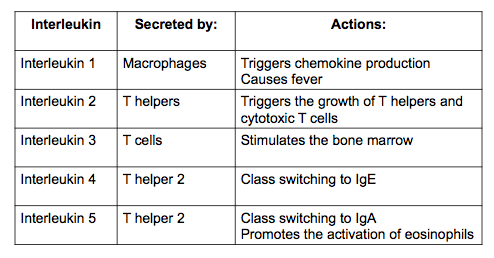WBR0490
| Author | [[PageAuthor::Rim Halaby, M.D. [1] (Reviewed by Yazan Daaboul, M.D.)]] |
|---|---|
| Exam Type | ExamType::USMLE Step 1 |
| Main Category | MainCategory::Immunology |
| Sub Category | SubCategory::General Principles |
| Prompt | [[Prompt::A 6-year-old girl is brought to her pediatrician's office for fever and runny nose. The fever started 2 days ago and has not been responsive to anytipyretic agents. Which of the following inflammatory mediators is involved in the patient’s fever?]] |
| Answer A | AnswerA::IL-1 |
| Answer A Explanation | [[AnswerAExp::IL-1 affects the activity of the hypothalamic thermoregulatory center, which leads to an increase in the core body temperature that results in fever. IL-1 is an endogenous pyrogen.]] |
| Answer B | AnswerB::IL-2 |
| Answer B Explanation | [[AnswerBExp::IL-2 is necessary for the growth, proliferation, and differentiation of T cells to become effector T cells. It is secreted by T helper cells.]] |
| Answer C | AnswerC::IL-3 |
| Answer C Explanation | [[AnswerCExp::IL-3 is secreted by basophils and activated T cells to support growth and differentiation of T cells from the bone marrow during an immune response.]] |
| Answer D | AnswerD::IL-4 |
| Answer D Explanation | [[AnswerDExp::IL-4 induces B-cell class switching to IgE and up-regulates MHC class II production. IL-4 decreases the production of Th1 cells, macrophages, IFN-gamma, and dendritic cells.]] |
| Answer E | AnswerE::IL-5 |
| Answer E Explanation | [[AnswerEExp::IL-5 is a major regulator of eosinophil accumulation in tissues.]] |
| Right Answer | RightAnswer::A |
| Explanation | [[Explanation::The average oral temperature of the human body is 37 °C (98.6 °F) and is strictly regulated under physiologic conditions by the hypothalamus. Fever is considered the hallmark of immune system activation. It is defined as an elevation of core body temperature that occurs by a cytokine-mediated inflammatory response. Fever is mediated by 2 triggers: endogenous pyrogens/cytokines and exogenous pyrogens. Both endogenous and exogenous pyrogens can act together to induce fever. Exogenous compounds, such as lipopolysaccarides (LPS) on gram-negative bacteria, induce the production of endogenous pro-inflammatory cytokines, such as IL-1, IL-6, INF-alpha, and TNF. Of all, IL-6 is the principal endogenous pyrogen and the strongest correlate to fever. These cytokines cross the blood brain barrier and access the hypothalamic circulation, release local prostaglandins, and reset the hypothalamic thermal setpoint to elevate the core body temperature. Fever is characterized by 3 clinical phases:
While some cytokines act as endogenous pyrogens, IL-10, arginine vasopressin, melanocyte-stimulating hormone, and glucocorticoides are considered endogenous antipyretics. Pharmacologic agents may also be antipyretics, such as acetaminophen, aspirin, and NSAIDs. Fever should be differentiated from hyperthermia, whereby the temperature setpoint in hyperthermia is not increased but the ratio of heat generation and heat dissipation is imbalanced. Exertional and non-exertional heat strokes are 2 examples of hyperthermia. Antipyretics are not effective in hyperthermia. Instead, rapid cooling using ice water (for exertional heat stroke) and passive cooling using fans (non-exertional heat stroke) are more useful in hyperthermia. Shown below is a table that summarizes the roles of interleukins and the cells that secrete them.
|
| Approved | Approved::Yes |
| Keyword | WBRKeyword::Interleukin, WBRKeyword::Fever, WBRKeyword::IL-1, WBRKeyword::Endogenous, WBRKeyword::Exogenous, WBRKeyword::Pyrogen, WBRKeyword::Hypothalamus, WBRKeyword::Core body temperature |
| Linked Question | Linked:: |
| Order in Linked Questions | LinkedOrder:: |
